by Winding Pathways | Aug 31, 2023 | Geology/Weather, Travel/Columns, Trees/Shrubs
Travels this summer showed how varied the North American continent’s vegetation, landscape, and weather are. Most recently we have journeyed from New Jersey to Southern Saskatchewan. Vegetation and terrain could not be more different.
Venturing from “Wide Open Spaces” to “Into the Woods”
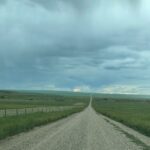
Native forbs and grasses cover the land.
The Dixie Girls’ refrain “Wide Open Spaces” describes the terrain we drove through in Southern Saskatchewan. One day Rich hiked to a high spot in Grasslands National Park. Beneath and beyond him were thousands of acres of grasslands – forbs and native grasses. Nary a tree poked upward in this vast and beautiful land.
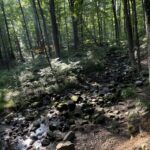
Brook waters tumble over rocks.
In contrast “Into the Woods” by Sondheim and Lapine would better characterize the roadside woods as our car approached New Jersey six weeks later. Jersey’s woods are so dense and thick that little sunlight filters through the leafy crown. On wood edges, impenetrable tangles of shrubs, brambles and vines seem to be everywhere.
Goldilocks Zone
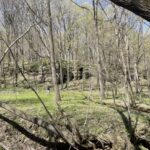
Iowa’s woodlands tend to be more open than eastern woods.
True to its location in “middle America,” our home in Eastern Iowa fits somewhere in between. You might say it is the “Goldilocks Zone” of vegetation. Midwestern woods tend to be more open than New Jersey’s but dense compared with Saskatchewan’s few low brushy areas. Iowa’s neither wide open nor dense but somewhere in between. It’s like a hybrid.
Location, Location, Location
What makes such a striking difference in vegetation extremes? These numbers tell part of the story:
Location Annual Precipitation Annual Mean Temp Wind
Saskatchewan 14” 39 F often and strong
New Jersey 54” 48 F calm to light
Iowa ranges in the middle with an average of 36” of precipitation.
Numbers don’t tell it all. New Jersey’s climate is moderated by the ocean, so the hottest temperature ever recorded near Rich’s hometown of Denville was 104 degrees Fahrenheit, and the coldest was -21. That’s a 125-degree variance. In Val Marie, Saskatchewan, the highest temperature ever recorded was 113 degrees Fahrenheit, and the lowest was -70. That’s a whopping 183-degree variance.
When we visited Val Marie, Saskatchewan, on the summer solstice, the sun was brilliant, the breezes gentle, and the night air cool. Sunsets lingered and the moon seemed to pop over the horizon and grace the landscape all night. Recently, thick smoke from wildfires blanketed the province like it has in Iowa and temperatures soared.
We hit New Jersey just right with warm day temperatures, a slight south breeze, tolerable humidity, and evenings that cooled down. The wildfire smoke had moved out. We were fortunate both times.
There’s more
Saskatchewan is much further north than New Jersey, so it receives significantly more summer light and much less sunlight in winter. Generally, Saskatchewan enjoys low humidity, while Jersey sweats in humid air year-round.
These differences in light and temperature plus topography, soil type, and the way people manage the landform its appearance and determine what species of plants and wildlife can exist there.
We noticed that people who live in the thickly wooded East are sometimes uncomfortable when traveling in the West’s wide-open spaces and Westerners feel claustrophobic amid the thick growth in the East. Comfort levels vary with the terrain.
Commonality
Both Saskatchewan and New Jersey do share a common feature. Rocks! Everywhere are pebbles, rocks, and boulders. Saskatchewan was glaciated and rocks, carried in by sheets of ice, litter the fields. Piles dot the fields where ranchers and farmers have piled them so they can till the sandy-type soil. New Jersey’s rocks are often bedrock with glacial striations and miles of rock and stone walls.
-
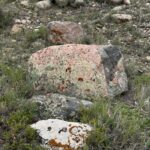
-
Lichen-covered boulders
-
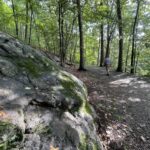
-
New Jersey’s inland landscape is defined by boulders.
What’s the difference between a rock wall and a stone wall? Well, there really isn’t. Both are made of rocks. But some, like rounded glacial rocks, were hauled from fields and tossed into rows to make boundaries. It takes a lot of work to maintain them. As Robert Frost stated in one poem, “Good fences make good neighbors.”
Others, flatter rocks like slate and shale, are easier to fit together. Marion’s dad was a stone worker crafting rock walls, carefully choosing rocks to fit well together. These rock walls stand for decades. At any rate, both Saskatchewan and New Jersey have an abundance of rocks that influence how land is used.
One of our traveling pleasures is noting vegetation and topography through our car’s windows, even as we speed along. To us, all places are interesting, and no matter what the terrain and vegetation we’re passing through it’s fascinating.
by Winding Pathways | Mar 9, 2023 | Foraging, Geology/Weather, Maple Syruping
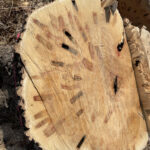
A slice of history.
Scars in a tree at the Indian Creek Nature Center reveal maple syruping history.
Back in 1979 Rich Patterson and volunteers approached a husky Box Elder tree, armed with a drill, spile, and buckets. It was early March. Nights were cold and frosty, followed by warm sunny days. Syrupin’ weather.
Oozing Out the Sap
As soon as the drill’s bit cut through the tree’s bark, clear watery sap oozed out.
Rich gently tapped in a metal spile and hung a bucket under it. By day’s end, two gallons of clear sap nearly filled the pail ready to be boiled into syrup.
-
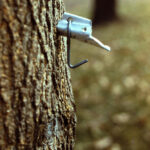
-
The spile angles slightly downward.
-
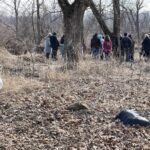
-
Visitors and plastic bag on tree
If not overdone tapping just harvests a small percentage of a tree’s sap. It’s sort of like a person giving blood. Taking a little does no harm. Healthy trees quickly create a scab over the tap hole, somewhat like a human body heals a scratch. As the tree grows and its trunk diameter swells, wood forms over the old tap hole. It’s fine to tap that tree again next year, the year after, and every following year.
Syruping season ends when night temperatures don’t drop below freezing. That’s when spiles are pulled, leaving the hole for the tree to heal.
Aging Out of Production
That’s what happened to the Nature Center’s tree. Box Elders are true maples capable of producing sap for quality syrup, but they are short-lived. An 80-year-old Box Elder is, well, elder and near life’s end. After being tapped for 40 years in a row the Nature Center’s box elder reached the end of its days converting solar energy into sugar. After its death staff felled it, revealing at least 30 tap scars. The oldest ones are closest to the center of the tree’s trunk.
Syruping is a fun late winter activity. To learn more visit the Indian Creek Nature Center during syruping season. It holds a fun Maple Syrup Festival in late March each year. For details check out Indian Creek Nature Center’s website.
Thanks, box elder for sharing some of your sap all these years.
-
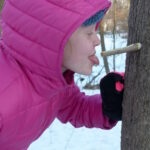
-
Tasting sap from a sumac spile
-
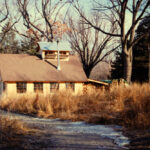
-
Syrupin’ time is upon us!
by Marion Patterson | Jun 2, 2022 | Chickens, Garden/Yard, Geology/Weather, Hoover's Hatchery, Preparedness, Reflections/Profiles, Travel/Columns
Coming up to a year from the last post on the features we wrote for the Cedar Rapids Gazette, here is an updated list for the second half of 2021 and the first half (almost) of 2022. These features are in addition to our regular work with Hoover’s Hatchery blogs and FB Live and our own blogs for Winding Pathways.
May 8, 2022. Splish Splash! Whitewater Kayaking in Iowa. (No link to date)
April 22, 2022. Finding America On Roadways East.
April 13, 2022. Muscle Over motor When Boating.
March 21, 2022. Rockhounding.
January 30, 2022. Backpacking Bonus. (8B of GZ. No link to date) Available Green Gazette.
January 24, 2022. Distinctive Religious Structures.
January 16, 2022. Hiking Wild Areas. (no link to date) Available Green Gazette.
December, 2021. Country Schools. (no link to date) Available Green Gazette
November 15, 2021. Making a (Mini) Pitch for Soccer.
October 6, 2021. A visit with Midwest’s Pioneering Authors.
September 8, 2021. Taking a Slow Boat to Cassville.
September 6, 2021. Camping in Iowa’s Trout Country & Decorah’s Celebrities.
August 4, 2021. Parking While Headed East. And Solar Panels at Peoples.
by Winding Pathways | Feb 17, 2022 | (Sub)Urban Homesteading, Geology/Weather, Reflections/Profiles
New England’s Nor’easter January 29-20, 2022
by Susan Fellows, guest blogger
What is a Nor-easter?
Dover, NH, 4:00 a.m. Temperature 5 degrees. The wind chill is probably close to -10 degrees. Wind gusts 40-45 mph throughout the day. What is a blizzard? Wind gusts more than 35 mph. Snow blowing and drifting. Visibility less than 1/4 mile. All more than three hours. We grew up with blizzards, know them well, and call them Nor’easters.
The description above is what I saw outside my living room window all day on January 29, 2022, in excess of eight hours. There is a large green space next to my apartment building with a stand of pine trees at the far end, where there is no snow. An area just outside my apartment going out about 20-30 feet where the wind blew the snow off all day long made it look like we had only a dusting of snow. Beyond that, snow accumulated up to 1″-2″ per hour for several hours. Most of the day, I could not see the trees which are less than a 1/4 mile away.
-
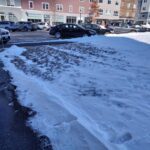
-
Strong winds swept some areas bare of snow.
-
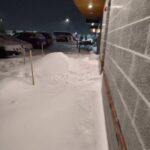
-
The building blocked the wind.
Following the Progress of the Storm
The well-predicted storm made its way up the coast from South Carolina, past Washington, DC, Philadelphia, and New York to New England. Snowfall reported in Bridgewater, MA, totaled 32″! Out at Wellfleet on the south side of Cape Cod, wind gusts reached 82 mph. Fortunately, in Dover, NH, we weren’t hit with as much snow and wind gusts were in the 40 mph range. Most of the day and into the evening I watched snow blowing horizontally past the windows. Whiteout! An all-day blizzard.
Venturing Out
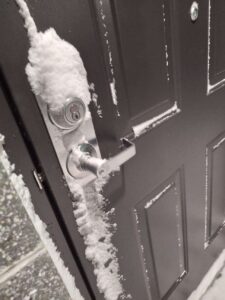
Opening the door was difficult
7:30 p.m. I decided to get my mail if there was any. True to the USPO motto, through rain, wind, snow, and dark of night the Post Office did deliver the mail! Getting out my door was difficult as the snow had accumulated to about three feet. So, it was hard to open the door. Along the sidewall of the building I trudged. Not as much snow there. But, once I reached the lobby door, I had to get to the security post to swipe my key fob to open that door. Snow spilled into my boots and I had to shove the door open about a foot to squeeze through. After picking up my mail, I made my way back to my apartment.
Manager & Snow Crews Respond to Safety Concern
The snowfall seemed to be easing up but it was hard to tell as the wind still picked up and carried snow horizontally past my window. Remembering that some Eastern big cities had had fires in apartments recently, I was concerned with conditions by the exit doors. So, I called the answering service of the apartment complex. Shortly our maintenance supervisor returned my call. I explained the situation and my concern that in case of an emergency requiring evacuation of the building the other residents might not be able to get safely out. He replied that the snow removal team would return the next morning. After some discussion, with the supervisor being unrelenting with his statement that the team would be back in the morning, I simply asked who would be liable if an evacuation were needed and people could not safely get out. Then, I hung up.
Soon after the property manager called, respected the fact that I was observing the conditions and he wasn’t. He called the supervisor of the snow removal team. Within the hour they arrived! I was relieved!
Blindingly Beautiful
Sunday, January 30, 2022. The day dawned bright and beautiful! What a change from not being able to see because of the blizzard! People were out with their pets and children enjoying the light, fluffy snow. The snow removal team cleared the overflow lots and residents moved their cars so the parking log could be properly cleared. Gigantic piles of snow were all over the place and sidewalks, doorways, and cars cleared of the eight inches of reported snow. One town, right on the ocean about 12 miles away, got the state’s grand total of 13.5″. The wind, she kept on blowing and the temperatures were bitterly, brutally cold.
-
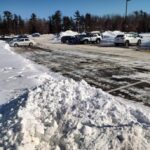
-
People moved their cars to help with snow removal.
-
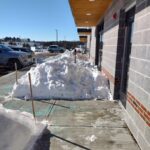
-
The doorways are cleared of snow.
-
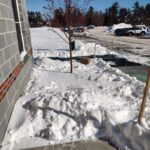
-
The snow removal team quickly cleared snow.
The next day, in appreciation, I called the supervisor to thank the crews for coming out in the storm and making sure residents were safe.
Prior to the storm, everyone had been told to stay off the roads, which they did. All-day Saturday, I had watched a storm tracker show from a Boston station. Indeed except for plows and utility crews restoring power, the roadways were clear of vehicles.
I LOVE SNOW and this was quite an event!
by Winding Pathways | Feb 18, 2021 | Birds, Geology/Weather
As we ate breakfast during the deep freeze that descended on February 7th six wild turkeys trudged through the snow from nearby woods and feasted on corn scattered under our bird feeders. It was 20 below zero – genuine 20 below. With the wind chill, the air was even colder.
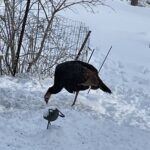
Warming toes.
The turkeys each stood on one leg as they pecked corn. Every once in a while, they alternated legs. One leg was always holding the bird upright while the other was tucked in the bird’s feathers. We wondered how they do this, so we went to our favorite new bird book, David Allen Sibley’s, What It’s Like to Be A Bird. According to him, birds have several adaptations that make it possible.
Here’s what he wrote, “The center of mass on their body is below the knee and a knob on the pelvis prevents the leg from angling any higher. Balancing on one leg requires angling that leg so that the foot is directly below the body, and with the leg essentially locked in position, and the body leaning against the leg, tiny adjustments of the toes are all that’s needed to stay upright.”
We often wonder how ducks and geese keep their legs and feet from freezing when swimming in frigid water or standing on ice. They have a useful adaptation. A bird’s leg is high, muscled, and covered with feathers. What we see that looks like a naked leg is actually a modified ankle, containing bones and tendons yet lacking blood vessels. So, the vascular area remains warm beneath feathers as the bird stands on the ice.
David Allen Sibley
We had the good fortune to chat with David Allen Sibley after he gave a presentation at the Outdoor Writers Association of America conference a few years ago. An astute ornithologist, writer, and artist, his books on bird identification and behavior, and his tree identification book, are always close at hand in our home. We’ve learned much from him.
Birds Need Grit in Winter
Most bird species need to occasionally eat tiny pebbles. These end up in the gizzard, a powerfully muscled pouch, where pebbles act like grindstones reducing hard seeds into a slurry for digestion.
During periods of snow and ice birds have a tough time finding grit, so about once a week we toss grit beneath the feeders. Sand works, but we usually use fine and medium-sized grit sold to help chickens digest their feed. Once the snow melts there’s no need to add grit, as birds easily find plenty of natural tiny pebbles.
-
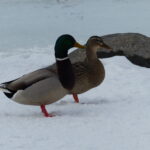
-
Adapted to the cold
-
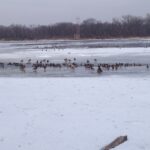
-
Weather adaptations
by Winding Pathways | Feb 4, 2021 | Geology/Weather
Obsidian on the Move
We have it easy. If we need to carve a roasted turkey, chunk up an apple, whittle a stick, or shave off a beard we just have to buy a knife or razor blade. They’re made in hundreds of shapes and configurations and sold in dozens of stores.
It wasn’t always that easy. A fascinating article about archeology in Yellowstone National Park is in the January/February 2021 issue of SMITHSONIAN Magazine. It gives a glimpse into yesterday.
Growing up in the 1950s and 1960s we were told that, before Columbus, Native Americans lived in primitive tribes that lacked technical sophistication.
The information was downright wrong.
Research Reveals Facts
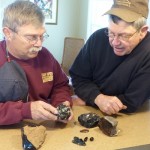
Looking over Obsidian samples.
Decades of research by archeologists and historians have proved that Native Americans had complex societies and vast ability to live sustainably off the land. The Smithsonian article gives a glimpse of how pre–Columbian North Americans made amazingly effective tools that were carried around the continent on vast trade networks.
Early Americans needed sharp tools to make clothing, butcher game, process plants for food, and make weapons and ornaments. They lacked steel but had one thing almost better than metal – obsidian and other rocks that could be fabricated into outstanding tools. Even today, no steel knife is as sharp as an obsidian blade.
Between Mammoth and Norris in Yellowstone Park is Obsidian Cliff, the source of some of the best obsidian in North America. It had been mined by Native Americans for thousands of years and traded widely. Obsidian artifacts can often be traced to their place of origin and some items made from Yellowstone rock have been found as far away as Hopewell in Ohio.
Origin and Sources of Obsidian
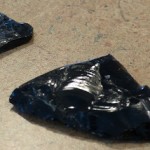
The smaller piece is the back of a point. The larger piece is the broken tip of a point.
Obsidian is formed when molten rock with high silica content cools rapidly, creating a natural glass. It fractures in fascinating patterns with keen edges. A skilled person can craft amazingly sharp and beautiful cutting tools from it.
Obsidian is found on most continents and has been used by people in Africa for hundreds of thousands of years. In the United States it’s found in Arizona, Colorado, New Mexico, Texas, Utah, Washington, Oregon, and Idaho, all western states, but some have been discovered in Pennsylvania and Virginia. It’s always an indication of past volcanism.
Obsidian on the Move
It’s fascinating to think how obsidian got from Yellowstone to Ohio. Obviously, someone, or maybe many people in a relay, carried it the 1700 miles to Hopewell. Obsidian was so valuable that it made the trip worthwhile. It proves that Americans long before Columbus were involved in mining, long-distance travel, commerce, and manufacturing.
Winding Pathways is in Iowa. Nearly our entire state has a bedrock of limestone, a sedimentary rock. We lack evidence of volcanoes so no natural occurring obsidian has been found here. However, obsidian wasn’t the only rock used in trade and tool making. Iowa archeologists have discovered tools made from rocks that had been carried long distances.
-
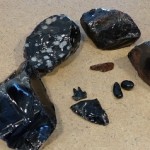
-
A volcanic glass, Obsidian occurs in volcanic areas such as the western United States.
-

-
Obsidian has one characteristic that slag generally lacks – a hint of translucence.
-

-
Translucent
Other Sharp Stones
According to Iowa State Archeologist, John Doershuk, there are dozens of varieties of chert that can be sourced to specific areas, knife River (ND) flint, Hixon silicified sandstone, jaspers, chalcedonies, and other rocks that came from distant points but were made into tools found in Iowa. Native people also transported and used copper and shells long before Columbus.
Winding Pathways is on an ancient sand dune high above Indian Creek. We’ve never found a natural rock on our property but love looking for stones when we walk along the Cedar River or other Iowa waterways. We often find chert that’s not been worked into tools but is still an interesting rock, and we keep looking for artifacts.
We know how lucky we are. If we need a new knife to slice a loaf of fresh bread, we don’t need to walk to Yellowstone to gather obsidian but can easily and inexpensively buy a knife at many stores near home.
























